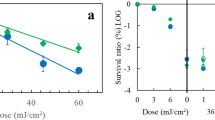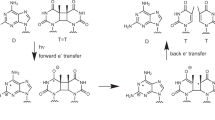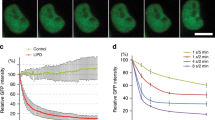Abstract
THE study of the control of protein synthesis in eukariotic cells usually involves the use of chemical inhibitors of macromolecule synthesis1. The drawback of these procedures is that the inhibitors have side effects which do not allow conclusive interpretations. Furthermore, the precise timing of the inhibitor effect is not always possible due to the lack of knowledge of the effective in vivo concentration and the rate of its entry into the cells. Furocoumarins (psoralens) photosensitise biological systems to near ultraviolet (NUV) light (300–400 nm) (refs 2–4). Psoralen and its derivatives react with pyrimidine bases in DNA when irradiated with NUV light to form monoadducts and DNA crosslinks5,6, the latter being the main lesion responsible for the biological damage in bacteria and mammalian cells4,7. Since the photoreactions in the cells are specifically with DNA8,9 and lead to its immediate inactivation as a template for DNA and RNA synthesis9, we have considered the use of this system for the study of control of protein synthesis. The degree of inactivation of DNA can be easily controlled by varying the NUV light dose, thus avoiding the complications involved in the use of drugs.
This is a preview of subscription content, access via your institution
Access options
Subscribe to this journal
Receive 51 print issues and online access
$199.00 per year
only $3.90 per issue
Buy this article
- Purchase on Springer Link
- Instant access to full article PDF
Prices may be subject to local taxes which are calculated during checkout
Similar content being viewed by others
References
Miura, Y. Antibiotics and Repliceetin (Calbiochem, San Diego, 1974).
Musajo, L., Rodighiero, G., Colombo, J., Torlone, V. & Dall'Acqua, F. Experientia 21, 22 (1965).
Oginsky, E., Green, G., Grifith, D. & Fowlks, W. J. Bact. 78, 821 (1959).
Ben-Hur, E. & Elkind, M. M. Mutat. Res. 18, 315 (1973).
Musajo, L. Proc. 3rd int. Cong. Radiat. Res. (ed. Silini, G.) 803–812 (North Holland, Amsterdam, 1966).
Ben-Hur, E. & Elkind, M. M. Biochim. biophys. Acta 331, 181 (1973).
Cole, R. S. J. Bact. 107, 846 (1971).
Pathak, M. A., Kramer, D. M. & Fitzpatrick, T. B. in Sunlight and Man (eds Fitzpatrick, T. B., Pathak, M. A., Harber, L. C., Seiji, M. & Kukita, A.) 335–368 (University of Tokyo Press, Tokyo, 1974).
Bordin, F., Baccichetti, F. & Musajo, L. Experientia 28, 148 (1972).
Filner, P. Devl Biol. suppl. 3, 206 (1969).
Filner, P. Biochim. biophys. Acta 118, 299 (1966).
Ferrari, T. E., Yoder, O. C. & Filner, P. Pl. Physiol. 51, 432 (1973).
Heimer, Y. M. & Filner, P. Biochim. biophys. Acta 230, 362 (1971).
Author information
Authors and Affiliations
Rights and permissions
About this article
Cite this article
HEIMER, Y., BEN-HUR, E. & RIKLIS, E. Psoralen and near ultraviolet light; a probe for study of control of protein synthesis. Nature 268, 170–171 (1977). https://doi.org/10.1038/268170a0
Received:
Accepted:
Issue Date:
DOI: https://doi.org/10.1038/268170a0
This article is cited by
-
Effects of radioprotectors on DNA repair capacity of tumor cells
Archives of Pharmacal Research (1993)
-
Inhibition of interferon production and antiviral action in mouse cells by 4,5?,8-trimethylpsoralen activated with near ultraviolet light
Archives of Virology (1980)
Comments
By submitting a comment you agree to abide by our Terms and Community Guidelines. If you find something abusive or that does not comply with our terms or guidelines please flag it as inappropriate.



